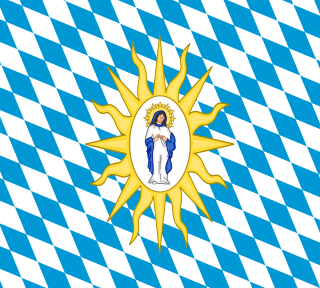
The Electoral Palatinate or the Palatinate, officially the Electorate of the Palatinate, was a constituent state of the Holy Roman Empire. The electorate had its origins under the rulership of the Counts Palatine of Lotharingia in 915; it was then restructured under the Counts Palatine of the Rhine in 1085. From 1214 until the Electoral Palatinate was merged into the Kingdom of Bavaria in 1805, the House of Wittelsbach provided the Counts Palatine or Electors. These counts palatine of the Rhine would serve as prince-electors from "time immemorial", and were noted as such in a papal letter of 1261; they were confirmed as electors by the Golden Bull of 1356.

Heidelberg is the fifth-largest city in the German state of Baden-Württemberg, and with a population of about 163,000, of which roughly a quarter consists of students, it is Germany's 51st-largest city. Located about 78 km (48 mi) south of Frankfurt, Heidelberg is part of the densely populated Rhine-Neckar Metropolitan Region which has its center in Mannheim.

Frederick V was the Elector Palatine of the Rhine in the Holy Roman Empire from 1610 to 1623, and reigned as King of Bohemia from 1619 to 1620. He was forced to abdicate both roles, and the brevity of his reign in Bohemia earned him the derisive sobriquet "the Winter King".

The Catholic League was a coalition of Catholic states of the Holy Roman Empire formed 10 July 1609. While initially formed as a confederation to act politically to negotiate issues vis-à-vis the Protestant Union, modelled on the more intransigent ultra-Catholic French Catholic League (1576), it was subsequently concluded as a military alliance "for the defence of the Catholic religion and peace within the Empire".

The Heidelberg Catechism (1563), one of the Three Forms of Unity, is a Reformed catechism taking the form of a series of questions and answers, for use in teaching Reformed Christian doctrine. It was published in 1563 in Heidelberg, Germany. Its original title translates to Catechism, or Christian Instruction, according to the Usages of the Churches and Schools of the Electoral Palatinate. Commissioned by the prince-elector of the Electoral Palatinate, it is sometimes referred to as the 'Palatinate Catechism.' It has been translated into many languages and is regarded as one of the most influential of the Reformed catechisms. Today, the Catechism is 'probably the most frequently read Reformed confessional text worldwide.'

Johann Heinrich Alting, German divine, was born at Emden, where his father, Menso Alting (1541–1612), was minister.

Heidelberg Castle is a ruin in Germany and landmark of Heidelberg. The castle ruins are among the most important Renaissance structures north of the Alps.

David Pareus was a German Reformed Protestant theologian and reformer.

Frederick III of Simmern, the Pious, Elector Palatine of the Rhine was a ruler from the house of Wittelsbach, specifically the cadet branch of Palatinate-Simmern-Sponheim. He was a son of John II of Simmern and inherited the Palatinate from the childless Elector Otto-Henry, Elector Palatine (Ottheinrich) in 1559. He was a devout convert to Calvinism, and made the Reformed confession the official religion of his domain by overseeing the composition and promulgation of the Heidelberg Catechism. His support of Calvinism gave the German Reformed movement a foothold within the Holy Roman Empire.

The Duchy of Palatinate-Zweibrücken was a duchy of the Holy Roman Empire with full voting rights to the Reichstag. Its capital was Zweibrücken. The reigning house, a branch of the Wittelsbach dynasty, was also the Royal House of Sweden from 1654 to 1720.

Wilhelmsfeld is a municipality in the Rhein-Neckar-Kreis of Baden-Württemberg in Germany.
The Edict of Torda was a decree that authorized local communities to freely elect their preachers in the Eastern Hungarian Kingdom of John Sigismund Zápolya. The delegates of the Three Nations of Transylvania – the Hungarian nobles, Transylvanian Saxons, and Székelys – adopted it at the request of the monarch's Antitrinitarian court preacher, Ferenc Dávid, in Torda on 28 January 1568. Though it did not acknowledge an individual's right to religious freedom, in sanctioning the existence of a radical Christian religion in a European state, the decree was an unprecedented act of religious tolerance.
Matthias Vehe known as Glirius (c.1545-1590) was a German Protestant religious radical, who converted to a form of Judaism and anti-trinitarianism, rejecting the New Testament as revelation.

Abraham Scultetus was a German professor of theology, and the court preacher for the Elector of the Palatinate Frederick V.

Jacob Palaeologus, also called Giacomo da Chio, was a Dominican friar who renounced his religious vows and became an antitrinitarian theologian. A polemicist against both Calvinism and Papal Power, Palaeologus cultivated a wide range of high-placed contacts and correspondents in the imperial, royal, and aristocratic households in Eastern Europe and the Ottoman Empire; while formulating and propagating a radically heterodox version of Christianity, in which Jesus Christ was not to be invoked in worship, and where differences between Christianity, Islam, and Judaism were rejected as spurious fabrications. He was continually pursued by his many enemies, repeatedly escaping through his many covert supporters.

Pierre Boquin was a French Reformed Theologian who played a critical role in the Reformation of the Electoral Palatinate.
Adam Neuser was a Protestant pastor of Heidelberg who held Antitrinitarian views.
Maximilian Mörlin was a Lutheran theologian, court preacher, Superintendent in Coburg, and Reformer.
Johann Hasler, also known as Haslerus, was a 16th-century Swiss theologian and physician. He is known for his association with a group of antitrinitarians including Johann Sylvan and Adam Neuser and for developing Galen's concept of heat and cold into the idea of a scale of temperature.














